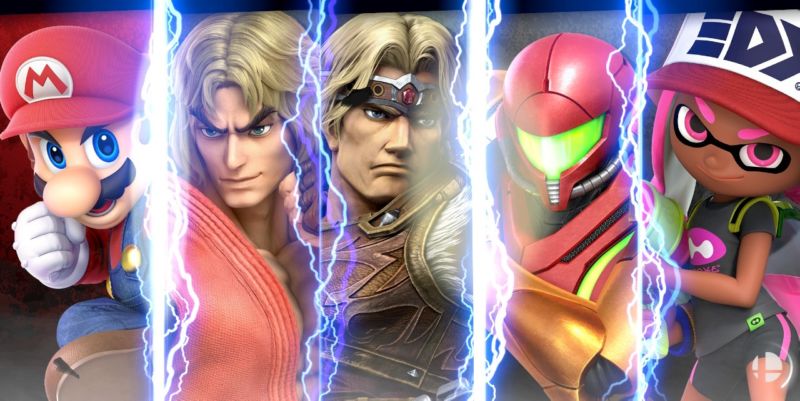
It's not enough that the game ships with dozens of gaming-nostalgia icons. The big-name Nintendo mascots (Mario, Link, Pikachu), the more obscure company wild cards (Ice Climbers, ROB, "Dark" Pit), and the beloved third-party guests (Solid Snake, Sonic the Hedgehog, Final Fantasy VII's Cloud) are all back from older Smash games, fulfilling the development team's "every fighter ever" promise. They're joined by a cast of very welcome (and masterfully designed) newcomers, bringing the fighter selection up to 74.
But, wait, there's more: you'll fight across 103 battle arenas and bust out dozens of the game's items, assist trophies, and Pokemon helpers. If you were to shuffle the game's variables before every basic versus match, you'd likely need years to see the same battle appear twice. It's a lot—and that's not even counting the value of the seam-busting soundtrack.
Yet someone at the combined development teams of Sora Ltd and Bandai-Namco couldn't leave well enough alone. They were determined to deliver even more by way of a ridiculous combatant count: more than 1,200 classic characters. To be fair, this comes by way of a gimmick—a new single-player "Spirits" mode. Luckily for fans, the way Smash Ultimate achieves this ludicrous count is quite interesting, and occasionally fascinating.
Spirits isn't executed perfectly, and the single-player mode leaves a noticeable crater in the rest of the package—at least, if you come to Smash Ultimate expecting certain elements from earlier in the series to return. (After nearly 20 years of Smash games, that's likely.) But there's a reason Smash Ultimate can get away with its bonkers, thousand-fight conceit, especially during that mode's pacing fumbles.
The basic fact is, we could spend this entire review just talking about how refined, measured, and satisfying it is to pick up controllers and get into a four-player beatdown with friends. Smash Ultimate's basic foundation is good. Top-of-the-year good. Why-we-love-video-games good. And, thank goodness, the game's obsession with being capital-B Big doesn't get in the way of that fact.
I have been reviewing Smash games for a long, long time...
-
The game's final roster includes 74 individual characters...
-
...though nine of these count as "echo" fighters—meaning, they are over 90 percent identical to another character. You can stack "echoes" via a menu toggle, if you're picky about it.
-
With that toggle active, the roster looks like this, and you pick from either echo by moving your pointer to your chosen character and tapping the alternate image.
-
And, here, 103 levels to battle in. Each of these can be turned into "Battlefield" or "Final Destination" variants.
-
When you first boot Smash Ultimate, you can only use these eight combatants. This is the only screen I grabbed before going on an unlocking spree. This menu lets you adjust universal power tweaks for each, but only for local-versus modes. (Additional handicaps can be applied on top of these.)
-
Roughly every 10 minutes, Smash Ultimate serves you a new, locked fighter, which you must defeat in battle to claim as a playable character. These fights start out easy but become harder as you reach the 50s, 60s, and 70s.
-
Losing isn't the end of the world. They all come back for rematches (and get a little easier each time, in the case of tough ones). I only needed two days of "yes new Smash game!" excitement to unlock the full cast.
-
Who's that Pokem—er, not a Pokemon.
-
Yay! (She's great.)
Unsure what Smash Bros. is all about? For a refresher, return to our review of the series' 2014 entries on either 3DS or Wii U... or rewind back to April 1999, when my 17-year-old self reviewed the series' first N64 game for the Dallas Morning News. As I wrote back then:
The fighting system is remarkably different than most street fighters. Players fight on top of a floating platform, and the object is to knock all opponents off. Thus, mindless button-mashing won't win the fight alone, as proper technique is needed to stop an opponent from jumping back onto the platform. Also, players don't have to memorize ridiculous 20-button combos, because game play requires only three buttons and the analog stick. This simplicity makes the game accessible to any novice, but experts will appreciate how much strategy the game's unique style offers.
In the years since, Smash Bros' core fisticuffs have stuck to this philosophy while expanding the selection of fighters and items. Though Ultimate has dozens more new items, their sum-total impact is pretty much the same as in other Smash games. Leave them on, and your fight strategy will revolve around movement and control of these tide-turning items. Otherwise, they all pretty much work in a "get item, get boost" way, so the ability to customize which ones appear (or remove them altogether) is appreciated. Play with them on for zany fun that drives every player equally insane; turn them down and cull your favorites for some classic, Mario Kart-style juice; or turn them off for pure Smash combat.
As for the cast, 2008's Smash Bros. Brawl was the first to kick any of the series' older characters to the curb, while 2014's Smash 4 left a few fighters behind—but neither was a slouch in beefing up the combatant roster. Simply getting all of those characters back as a full-cast reunion gets the count up to 63 (this tally combines three Pokemon monsters as a single "Pokemon Trainer" fighter, to be specific).
Those 63 returning faves are joined by another 11 newbies, but technically, five of these "brand-new" cast members are actually known as "echo" fighters—meaning, they're over 90 percent identical to another cast member. One example of this is Smash 4's Ryu from the Street Fighter series. He's back in Ultimate, and he's joined by a new-to-Smash fighter you may have heard of: Ken Masters. Just like in Street Fighter, Ken and Ryu have largely identical move sets with subtle differences in animations, speed, power, and specific perks.
reader comments
72